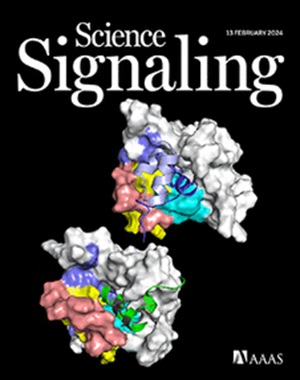The E3 ligase TRIM21 promotes progression of pancreatic ductal adenocarcinoma by down-regulating TAp63α and derepressing IL20RB
IF 6.6
1区 生物学
Q1 BIOCHEMISTRY & MOLECULAR BIOLOGY
引用次数: 0
Abstract
Pancreatic ductal adenocarcinoma (PDAC) is an aggressive tumor and frequently has mutations in the transcription factor p53. TAp63α is a member of the p53 protein family that is generally tumor suppressive in various other p53-mutant or p53-deficient cancers. Here, we found that TAp63α inhibited cell proliferation, epithelial-mesenchymal transition (EMT), and migration in several p53-mutant PDAC cell lines. TAp63α transcriptionally repressed IL20RB (which encodes a subunit of the interleukin-20 receptor), potentially by inducing the methylation of its promoter. However, mutations in p53 or KRAS that are common in PDAC increased the abundance of the E3 ligase TRIM21, which promoted the ubiquitin-dependent degradation of TAp63α. Thus, the degradation of TAp63α enabled increases in IL20RB expression and formation of IL-20 receptors, resulting in the activation of downstream JAK1-STAT3 signaling that stimulated the proliferation, EMT, migration, and in vivo metastatic seeding of PDAC cells. Our findings identify a signaling axis involving TRIM21, TAp63α, and IL-20RB in PDAC progression.
E3连接酶TRIM21通过下调TAp63α和抑制IL20RB促进胰腺导管腺癌的进展
胰腺导管腺癌(PDAC)是一种侵袭性肿瘤,其转录因子p53经常发生突变。TAp63α是p53蛋白家族的成员,在其他多种p53突变或p53缺陷癌症中通常具有肿瘤抑制作用。本研究发现,在几种p53突变的PDAC细胞系中,TAp63α抑制细胞增殖、上皮-间质转化(EMT)和迁移。TAp63α转录抑制IL20RB(编码白介素-20受体的一个亚基),可能是通过诱导其启动子的甲基化。然而,PDAC中常见的p53或KRAS突变增加了E3连接酶TRIM21的丰度,从而促进了泛素依赖性的TAp63α降解。因此,TAp63α的降解使IL20RB表达和IL-20受体的形成增加,导致下游JAK1-STAT3信号的激活,从而刺激PDAC细胞的增殖、EMT、迁移和体内转移播种。我们的研究结果确定了在PDAC进展中涉及TRIM21、TAp63α和IL-20RB的信号轴。
本文章由计算机程序翻译,如有差异,请以英文原文为准。
求助全文
约1分钟内获得全文
求助全文
来源期刊

Science Signaling
BIOCHEMISTRY & MOLECULAR BIOLOGY-CELL BIOLOGY
CiteScore
9.50
自引率
0.00%
发文量
148
审稿时长
3-8 weeks
期刊介绍:
"Science Signaling" is a reputable, peer-reviewed journal dedicated to the exploration of cell communication mechanisms, offering a comprehensive view of the intricate processes that govern cellular regulation. This journal, published weekly online by the American Association for the Advancement of Science (AAAS), is a go-to resource for the latest research in cell signaling and its various facets.
The journal's scope encompasses a broad range of topics, including the study of signaling networks, synthetic biology, systems biology, and the application of these findings in drug discovery. It also delves into the computational and modeling aspects of regulatory pathways, providing insights into how cells communicate and respond to their environment.
In addition to publishing full-length articles that report on groundbreaking research, "Science Signaling" also features reviews that synthesize current knowledge in the field, focus articles that highlight specific areas of interest, and editor-written highlights that draw attention to particularly significant studies. This mix of content ensures that the journal serves as a valuable resource for both researchers and professionals looking to stay abreast of the latest advancements in cell communication science.
 求助内容:
求助内容: 应助结果提醒方式:
应助结果提醒方式:


